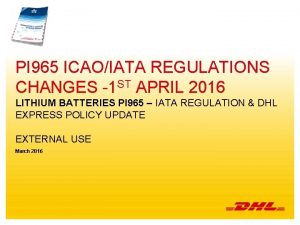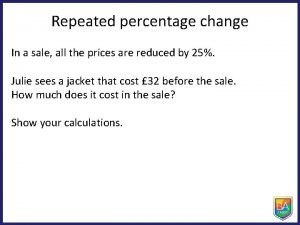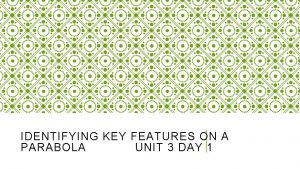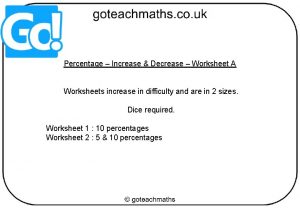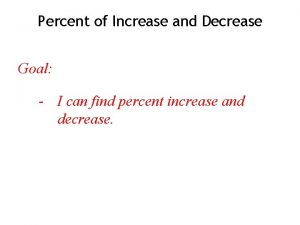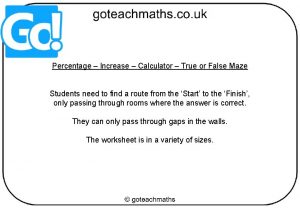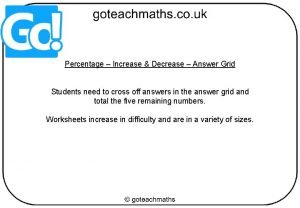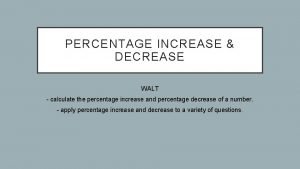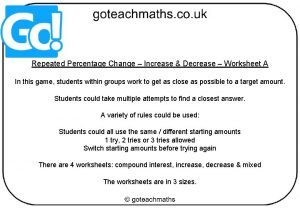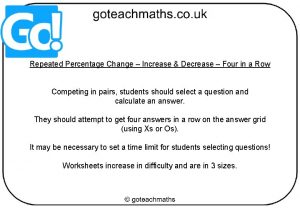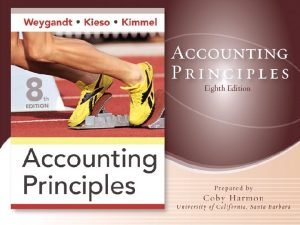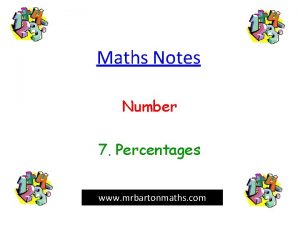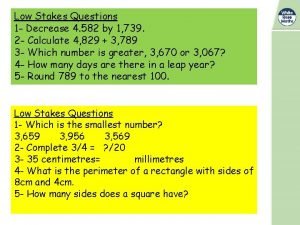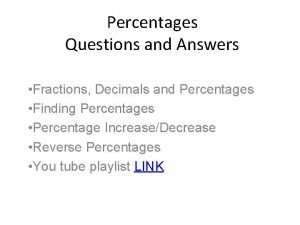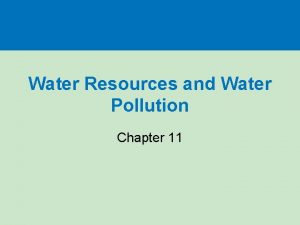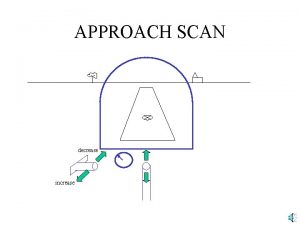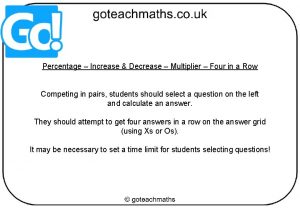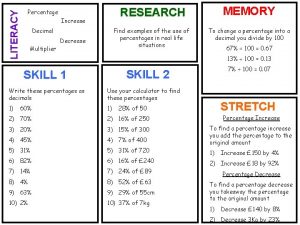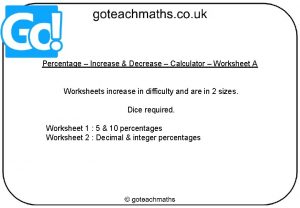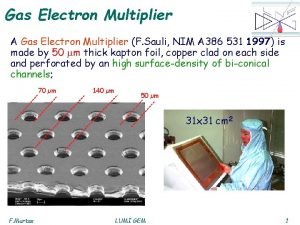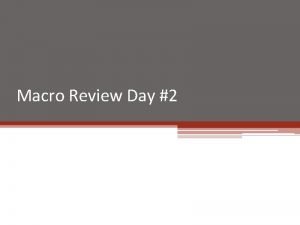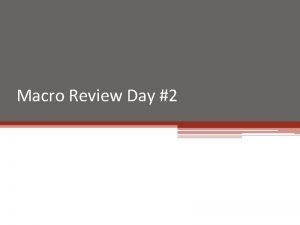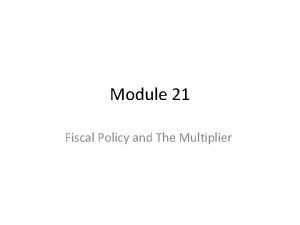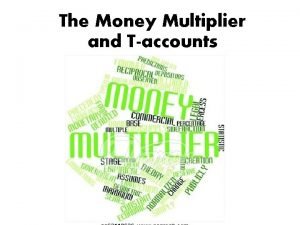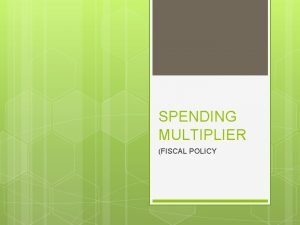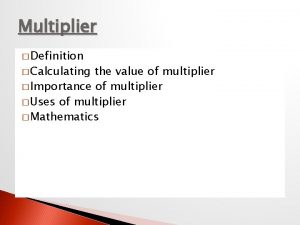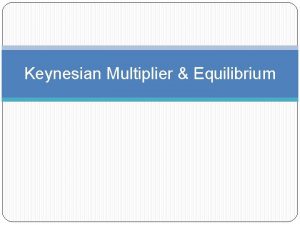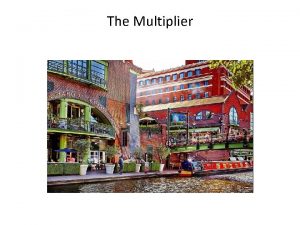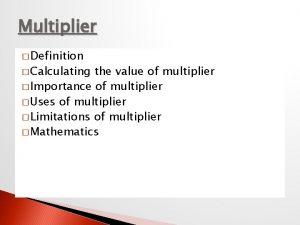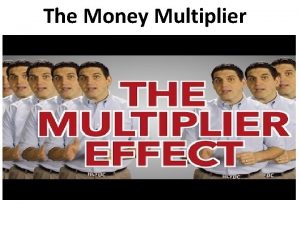Multiplier 5 increase 0 965 1 decrease 0


















- Slides: 18

Multiplier 5 % increase 0. 965 1 % decrease 0. 5 10 % increase 1. 005 3. 5 % decrease 0. 85 15 % increase 1 15 % decrease 1. 15 ½ % increase 1. 1 50 % decrease 0. 99 No change 1. 05 Match each phrase to the correct percentage multiplier

Simple Interest vs. Compound Interest An investment of £ 100 offers 5% simple interest per annum. An investment of £ 100 offers 5% compound interest per annum. The investment would grow as follows… End of Year 1: 100+5=£ 105 End of Year 2: 105+5=£ 110 End of Year 2: 105+5. 25=£ 110. 25 End of Year 3: 110+5=£ 120 End of Year 3: 110. 25+5. 51=£ 115. 76 Compound interest is the result of reinvesting interest so that the interest in the next period is greater.

Compound Interest £ 4000 is invested at 3% per annum compound interest. Find the total value of the investment after 2 years. Year 1 2 Initial Value at end of year

On your whiteboards: A man invests £ 5, 000 into a company and expects to make 5% per annum. How much will his investment be worth in three years? Multiplier Increase: 100 + 3 = 103% 103 ÷ 100 = 1. 03 Year Initial Value at end of year 1 2 5, 000 5, 250 5000 × 1. 05 = 5, 250 3 5, 512. 50 5512. 50 × 1. 05 ≈ 5, 788. 13 5250 × 1. 05 = 5, 512. 50

On your whiteboards: £ 14, 000 is invested at 7. 5% per annum compound interest. Find the total amount at the end of three years. Multiplier Increase: 100 + 7. 5 = 107. 5% 107. 5 ÷ 100 = 1. 075 Year Initial Value at end of year 1 2 14, 000 15, 050 14000 × 1. 075 = 15, 050 3 16, 178. 75 16178. 75 × 1. 075 ≈17, 392. 16 15050 × 1. 075 = 16, 178. 75

Compound Interest £ 4000 is invested at 3% per annum compound interest. Find the total value of the investment after 20 years. Year 1 2 Initial Value at end of year This method would be very time consuming for this question!

Compound Interest £ 4000 is invested at 3% per annum compound interest. Find the total value of the investment after 20 years. This calculation is more efficient.

Using boxes Number of years/months/ weeks… 200 Initial amount Percentage increase or decrease

Growth and Decay Worked Example A house is bought for £ 160, 000. It increases in value at a rate of 1. 3%. How much is the house worth after 5 years? Your Turn A house is bought for £ 160, 000. It increases in value at a rate of 0. 9%. How much is the house worth after 5 years?

Compound Interest Practise



Compound Depreciation A van is bought for £ 10, 000. It depreciates at a rate of 20%. Find it’s value after 3 years. Multiplier Decrease: 100 - 20= 80% 80 ÷ 100 = 0. 8 Year Initial Value at end of year 1 2 10, 000 8, 000 10000 × 0. 8 = 8, 000 3 6, 400 6400 × 0. 8 = 5, 120 8000 × 0. 8 = 6, 400

On your whiteboards: The value of machinery in a factory depreciates by 10% each year. The machinery was bought for £ 74, 000. What was its’ value after 2 years? Multiplier Decrease: 100 - 10 = 90% 90 ÷ 100 = 0. 9 Year 1 2 Initial Value at end of year 74, 000 66, 600 74000 × 0. 9 = 66, 600 66600 × 0. 9 = 59, 940

On your whiteboards: The polar ice cap in the Arctic is 4 metres thick. If the ice is thinning at a rate of 5% per year, how thick will the ice be in two years time? Multiplier Decrease: 100 - 5 = 95% 95 ÷ 100 = 0. 95 Year 1 2 Initial Thickness at end of year 4 3. 8 4 × 0. 95 = 3. 8 × 0. 95 = 3. 61 m

Growth and Decay Worked Example A house is bought for £ 99, 000. It depreciates in value at a rate of 1. 3%. How much is the house worth after 5 years? Your Turn A house is bought for £ 99, 000. It depreciates in value at a rate of 0. 9%. How much is the house worth after 5 years?

Reductions Practise

 Quantity supplied vs supply
Quantity supplied vs supply Pi965
Pi965 Simple interest
Simple interest Repeat percentage change
Repeat percentage change Identify the end behavior
Identify the end behavior Percentage increase and decrease worksheet
Percentage increase and decrease worksheet How to find the percentage increase
How to find the percentage increase Percent increase and decrease maze answer key
Percent increase and decrease maze answer key Answer
Answer God increase and i decrease
God increase and i decrease Find percentage increase
Find percentage increase Repeated percentage change calculator
Repeated percentage change calculator How to get percentage decrease
How to get percentage decrease Posting normally occurs before journalizing
Posting normally occurs before journalizing How to calculate percentage reverse
How to calculate percentage reverse 582 x 4
582 x 4 How to find percentage decrease
How to find percentage decrease How to work out percentage decrease
How to work out percentage decrease How to help reduce water pollution
How to help reduce water pollution

